

Response: "Flow" In The Classroom. Misdiagnosing Adverse Childhood Trauma as ADHD. The fact that one in every 11 school-age children in the United States is diagnosed with Attention Deficit Hyperactivity Disorder (ADHD) has warranted plenty of attention.
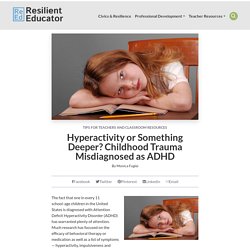
Much research has focused on the efficacy of behavioral therapy or medication as well as a list of symptoms — hyperactivity, impulsiveness and inattention — used to identify ADHD. According to the New York Times, the United States has one of the highest ADHD rates in the world, and nearly two-thirds of diagnosed children are treated with medication.
This increase may indicate that borderline cases are now identified and treated, bringing help to patients in need. However, doctors concerned with the spike in attention deficit disorder rates argue that the clinical criteria for diagnosis have blurred the line between normal and abnormal behavior — and question whether the well-known symptoms of ADHD can mask deeper issues in children. Are some childhood ADHD symptoms actually a response to trauma? Dr. Although Dr. 9 Best Differentiated Instruction Strategies for CTE. Teaching career and technical education (CTE) courses means you are challenged with reaching diverse students every day.
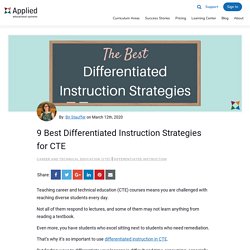
Not all of them respond to lectures, and some of them may not learn anything from reading a textbook. Even more, you have students who excel sitting next to students who need remediation. That’s why it’s so important to use differentiated instruction in CTE. But finding ways to differentiate your lessons is difficult and time-consuming, especially since you have regular classroom lessons as well as clinical labs! As a CTE curriculum developer, we hear from thousands of teachers like you every year, and they all have the same problem. Techniques to Help Struggling Students. Teachers know that students walk into their classrooms with a wide range of abilities.
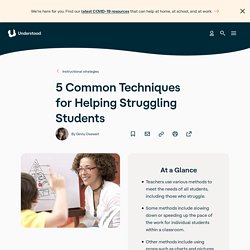
But teachers try to find ways to meet the needs of all students, including those with learning and thinking differences. Here are five common teaching methods. 1. Differentiated Instruction With this approach, teachers change and switch around what students need to learn, how they’ll learn it, and how to get the material across to them. This is a method that breaks learning into chunks. Teachers often use this method by presenting a model of high-quality work before asking students to work on their own. What Is Differentiated Instruction? Teaching Techniques, LD, ADHD. In any general education classroom, there are students with various learning styles.

Some learn best by reading and writing. Others prefer to watch a video, listen to a recording, or dig into hands-on activities. Strategies Teachers Use to Help Kids With Learning and Attention Issues. Your child’s teachers may use a variety of teaching strategies in their classrooms.

But do these strategies help kids who learn and think differently? There’s no one way for teachers to deliver instruction to their students. However, some strategies are backed by research and are more effective than others. These approaches and techniques can benefit all students. But they’re especially helpful to kids who learn and think differently. You may have heard of one or more of these strategies from your child’s classroom or special education teachers. Here are six common teaching strategies. Individualized vs. Differentiated Instruction. In a typical classroom, you’ll find students who are reading above their grade level and others who are behind.

You might find that some learn best by working with other kids, while others prefer working alone. And some students need special help along the way to fill in areas where they struggle. What Is Differentiated Instruction? Teaching Techniques, LD, ADHD. What Is an IEP. Education Evaluations: A Guide for Parents. Having your child evaluated can be a confusing and emotional journey, with a number of steps along the way.
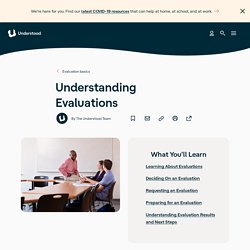
As you take each step, you may have questions and concerns. But at the end, you should have a clearer picture of why your child is struggling and how you and the school can help your child thrive. Learning about evaluations can help you feel more confident and prepared during the process. It also makes it easier to speak up for what your child needs, and helps pave the way for your child to do the same. This guide can help you navigate every step in your evaluation journey. Your child is having trouble in school, and you don’t know why.
What will the evaluation tell me about my child? Even when your child is struggling in school, it’s not always an easy decision to have your child evaluated. These types of uncertainties are common. What Is Differentiated Instruction? Teaching Techniques, LD, ADHD. 9 Best Differentiated Instruction Strategies for CTE. Techniques to Help Struggling Students. Sourds et malentendants, faciliter la communication. Portraits et initiatives. Guide scolariser eleves sourds et malentendants 142904. Le livret scolaire unique. Quoi ?
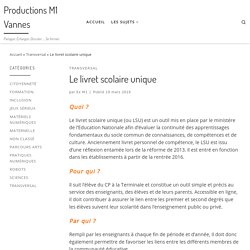
Le livret scolaire unique (ou LSU) est un outil mis en place par le ministère de l’Education Nationale afin d’évaluer la continuité des apprentissages fondamentaux du socle commun de connaissances, de compétences et de culture. Anciennement livret personnel de compétence, le LSU est issu d’une réflexion entamée lors de la réforme de 2013. Il est entré en fonction dans les établissements à partir de la rentrée 2016. Pour qui ? Il suit l’élève du CP à la Terminale et constitue un outil simple et précis au service des enseignants, des élèves et de leurs parents.
Par qui ? Rempli par les enseignants à chaque fin de période et d’année, il doit donc également permettre de favoriser les liens entre les différents membres de la communauté éducative. Et donc… Le LSU pour les enseignants « Ô rage, ô désespoir, ô livret ennemi N’ai-je tant enseigné que pour cette infamie… » Stop aux weekends entiers passés à remplir des livrets à la chaine. Asbl APEDAF Guide surdité WEB.
History of Learning Disabilities and ADHD. A Summary of the evidence on inclusive education. 4 Benefits of Inclusion Classrooms. When kids are found eligible for special education services, it’s common for their families to worry that they’ll be placed in a different classroom than other kids their age.

But most kids who are eligible for special education spend the majority of their time in general education classrooms. Many of those classrooms are what’s known as inclusive (or inclusion) classrooms. In an inclusive classroom, general education teachers and special education teachers work together to meet the needs of all students. This is key. As Carl A. Inclusive classes are set up in a number of ways. Other inclusive classes have special education teachers “ push in” at specific times during the day to teach (instead of pulling kids out of class to a separate room). For Learning and Thinking Differences. The Difference Between UDL and Traditional Education. 4 Benefits of Inclusion Classrooms. Individuals with Disabilities Education Act. United States law The Individuals with Disabilities Education Act (IDEA) is a four-part (A-D) piece of American legislation that ensures students with a disability are provided with Free Appropriate Public Education (FAPE) that is tailored to their individual needs.
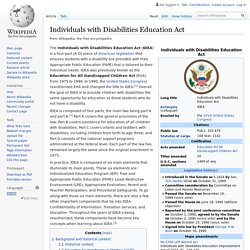
IDEA was previously known as the Education for All Handicapped Children Act (EHA) from 1975 to 1990.